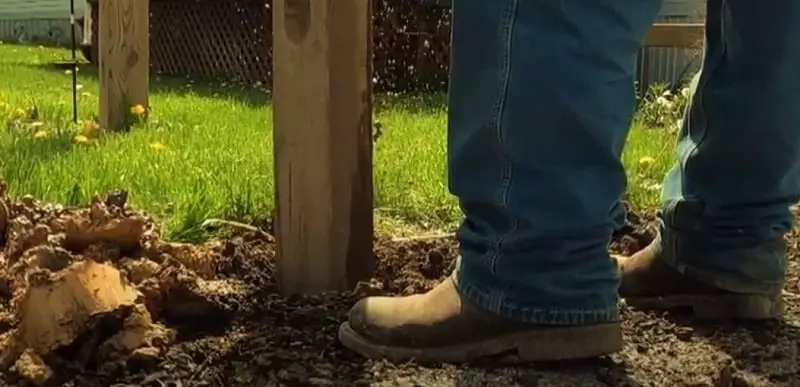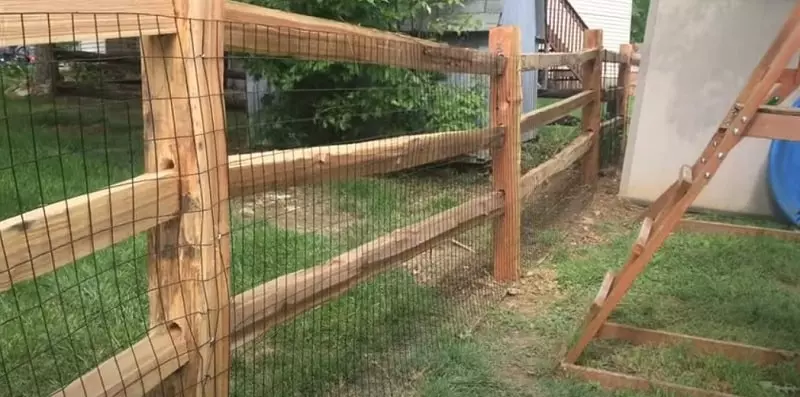Split rail fences are a cost-effective solution to other fencing styles and are easy to install. Split rail fences are generally used for front yard landscape decoration and containing livestock. The split rails are tapered in at the bottom and go into the line fences pretty easily.
You shouldn’t set split rail fence posts in concrete, as traditionally, these wooden fence posts are designed to be repairable, and setting them in concrete would make them impossible to replace if they rot. Impermeable soil causes water to sit in the pot your hole created and rot. Setting them in well-drained soil is the best solution.
It is essential to understand the correct way to install a split rail fence to increase the life of the wood. Let’s discuss how to set your wooden fence, how deep it should go into the ground, and what tools you will need for the job.

Table of Contents
How Do You Install A Split Rail Fence?
Before setting fence posts, you will need some tools. Having the correct tools to hand will make the job easier, and your DIY fence will look so much better. The list of tools you need include:
- Builders line
- Measuring tape
- Spray paint
- Spirit level
- Post hole digger
- Hammer
- Screwdriver
- Saw
- Fence post driver
- Shovel
- Post hole digger
1. Builders Line And Smaller Tools
Plot out where your fence should go. Mark the first fence post, then use the builder’s line and measuring tape to mark the next one, and so on.
You can mark the spot using spray paint to have the exact position of the second post. A spirit level ensures the fence post is level in the ground.
2. Post Hole Digger
A post-hole digger helps you to dig holes without breaking your back. It’s an excellent tool for digging holes before setting in your
3. Electrical Tools
If you prefer to use traditional tools like a hammer, saw, and a hammer, that’s fine if that’s what you prefer; however, assembling a fence is a lot of work, and electrical tools are more comfortable on the body.
4. Fence Post Driver
A post hole digger is an excellent tool, but for some jobs, you need to get the post deeper into the ground, and this is where a fence post driver comes in handy.
You will have lots of posts to drive for bigger projects, and they must all be at the correct height. The spirit level will ensure they are all at the right height.
Method
1. Using your post shovel and post hole digger, dig out a hole that’s about 10 inches in diameter and about 6 inches deeper than you require.
2. Pour gravel in the bottom of the hole to drain moisture away from the post. Position your post in the hole, and replace the soil, keeping it nice and compact.
3. Fill the ends first and ensure the posts are facing the right direction. Use your spirit level to ensure they are square.
4. Tamp the soil down firmly, and when you’re certain your post is set, mound up the soil around each post.
5. To ensure each post is at the right height, run a taut string to the tops of the end posts as a guide.
6. Dig your holes for your line posts carrying out the same procedure. When all your posts are in, insert the rails, and your split rail fence is completely assembled.
How Deep Should A Split Rail Post Be?
Holes for a split rail post should be 24 inches deep and 10 inches wide. A post hole digger is best to dig the post holes. Ensure that all of the markers on your post line up. You may need to dig deeper or add dirt to the hole for the posts to be at the correct height.
All posts must be straight from top to bottom. Using a long level, like a four-foot level, to ensure there is no warping on the wood.
When you position the fence, you can use compacted dirt or gravel to keep it stable. You can use cement to fill the holes; however, this could shorten the life of your post encased in it.
If you set it in concrete, position the post in the hole, fill 12 inches of compacted dirt. Fill the remainder with cement.
This forms a concrete collar while still allowing moisture to drain away from the post. Drainage is crucial for the longevity of the post. Ensure that you don’t set the post’s end entirely in cement, as this could void your warranty.
How Far Apart Do You Put Split Rail Fence Posts?
How far apart you space out the split rail fence posts depends on their length. Inquire with the supply company about the length of each of the rails. Some commonly available options include 9-feet and 11-feet long rails.
If you know the measurement, you can space them accordingly. 9-feet rails post every 8-feet, and 11-feet rails post every 10-feet.
How Long Do Split Rail Fence Posts Last?

The longevity of split rail fence posts depends on the wood. A cedar fence can last between 15 to 30 years, spruce and pine posts last half that length, treated or not.
Other factors affect the longevity of the wood, such as climate, moisture, soil composition, and maintenance. For example, harsh environments take 10 to 15% off the lifespan of your fence posts, while correct installation procedures and maintenance add 10 to 15%.
If you are wondering how to protect fence posts of lower grades, you should talk to a paint and stain dealer who can recommend a sealant to help prevent moisture damage.
Also, consider backfilling post holes with gravel rather than dirt or clay to stop water from contacting posts as the water will drain away.
Water-logged posts will rot pretty quickly; however, proper drainage along with sealing and staining can help wood fence parts last longer.
Fence rail sag is part of life, and you can’t prevent it; however, installing heavy rails at the start can delay it.
Industry-standard sizes include pony (10 to 14″ girth), standard (12 to 14″ girth), and jumbo (14 to 16″ girth). Using the heaviest grade possible is the optimum way to prevent sagging rails. If you must pony rails, keep them short like, 8* long to help prevent sag.
How Do You Maintain A Split Rail Fence?
Maintaining the beauty of your split fence is doable if you follow these seven maintenance steps:
1. Use Pressure Treated Lumber Timber
Pressure-treated wood is guaranteed t0 last longer than raw wood. This type of lumber comes ready from the factory to endure the worst of the weather.
Preservatives, sealants, UV inhibitors, and fungicides are forced into the rails using pressure to protect the wood all year round. Using only high-grade wood is non-negotiable.
2. Stain The Wood Often
Pressure-treated wood needs extra care. In the first few years, you must apply a stain to protect the wood. It is subject to the elements. A colored stain will enhance the natural quality of the wood and protect it from drying out in the sun.
3. Control The Plants And Grass
Keep plants, trees, and grass from growing in and near the fence, as the branches can transport termites onto the fence. In addition, trees can blow over and break your wooden fence.
Keeping grass and plants away will prolong the life of your wood.
4. Use Vinyl For Easy Maintenance
Vinyl is a popular material for ranchers as it can keep animals under control. Vinyl is a low-maintenance material, and it will help prevent rot and termites. In addition, it can help withstand damage and UV rays.
5. Use Fence Armor
Fence Armor helps to maintain a split fence by wrapping itself around the bottom of posts. The metal cover prevents animals from gnawing at the wood, which can wear down the structure.
6. On The Spot Repairs
This is a part of maintenance you cannot go without. If you see a problem, you must fix it immediately before it gets worse.
The tiniest crack can give access to termites and can spread pretty quickly. Broken and cracked fences can cause posts to fall. Doing immediate repairs will keep the structure strong.
7. Regular Inspections
Carrying out frequent inspections is as crucial as attending to repairs instantly. You must get out to the fence often. Check your fencing for signs of termite damage and rot.
Give the posts a shake and if any are loose, reset them into the ground until they are more stable.
Are Split Rail Fences Good For Keeping Animals In?
Split rail fences are ideal for keeping large and medium-sized animals confined to your property, so they are perfect for keeping in sheep, horses, and medium to large dogs.
However, you may wish to consider a three-rail structure to ensure there is no room for escape.
Wood split rail fences on their own are not ideal for confining small animals as they can escape through the gaps. However, you can use it as long as you combine it with mesh fencing.
Final Thoughts
Split rail fencing is an ideal cost-effective solution for protecting your pets and property. However, you must assemble it correctly.
It’s best not to set a split rail fence post in cement as these posts need drainage to last. Instead, you can backfill soil, rocks, or gravel compactly, and that will provide the much-needed drainage for your posts.
Recent Posts
Fences are important for keeping our homes safe. They help in preventing the entry of unwanted intruders and thus keeping our house secure. There are different types of fences available in the market...
If you are looking for privacy, then you will get that with vinyl fencing. They come in different styles, colors, heights, and prices making them budget-friendly.